 |
||
|
||
| ||
CONTENTS
It was spring when new NVIDIA products were announced. It is late June now but we still see no mass shipments of products although the company keeps saying that everything is all right and the cards are in large quantities. I never managed to explain this contradiction or come to any conclusion. Today we can see the following picture: not only the prices beat all the records (even Quantum3D Obsidian X-24 on two Voodoo2 exceeded USD 700), but accelerators are also nowhere to be seen. It reminds me of a popular parody of a slogan: "New Tampax! A bonus flip-flap in each tenth pack!". Only speaking about 6800 Ultra it would sound like this: "Each tenth card has a cooler that expands to 5 PCI slots, so your card will be as large as your PC!". But joking apart, we still hope that the accelerators announced back in April will finally reach the stores and have reasonable prices... Meanwhile, the company issued a product similar to 6800 Ultra, that only has lower frequencies. I think, you all know what NV40 (that is, GeForce 6800 with suffixes) is like. But just in case, here's a list of our comprehensive materials on that.
Theoretical materials and videocard reviews that concern
May NVIDIA officials not get offended at this introduction, but really, we can't be fed with promises all the time. Some of our colleagues visited factories of NVIDIA partners and all they were shown were empty PCBs prepared for GeForce 6800 production. There are no GPUs or memory chips (except those for GeForce 6800 that uses the already available 2.8ns memory). But let us keep our optimistic spirit. Hopefully, when the article is published, all we have said above will be stale and sink into oblivion. And now we better go back to our subject. We all know how fast ATI RADEON X800 PRO is advancing. Up to recent time, NVIDIA had no product competitive to it within the same price segment (USD 399). So, they decided to release an Ultra-like product that has cheaper GDDR3 2.0ns memory and a chip working at 350 instead of 400 MHz. It enabled NVIDIA to remove the second external power connector from the board as well as to minimise the cooling system. However, it all will be examined in details a bit later. Now, I'll only mention that the chip retains all 16 pixel pipelines (or 4 quads). As a result, GeForce 6800 GT fillrate 350 MHz x 16 pipelines = 5600 Mp/s will compete with X800 PRO's 475 MHz x 12 pipelines = 5700 Mp/s. As we see, the fillrates are almost identical. I believe, much will depend on bandwidth, and 6800 GT has a certain advantage here: 500 (1000) MHz vs. 450 (900) MHz in X800 PRO. Plus, differences in the architecture and other peculiarities will play a role too. Now let's look at the card which was provided by NVIDIA's Russian office.
Board
It is clearly seen that the card is based on the same PCB as 6800 Ultra. The only difference is that the second external power connector is absent. Now let's take a closer look at the cooling system.
GeForce 6800 GT is under the cooling system.
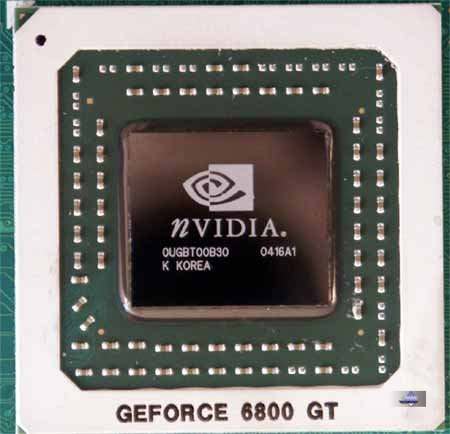 As we see, the marking is now partially on the die and partially on the cover as well.
The photo below enables to see that the cooler is really thin and will not hamper the board installation into the first PCI slot.
To check the temperature mode, we run the card (without overclocking) using no additional external cooling. RivaTuner showed that the core could heat up to 80°C.
 Speaking about overclocking, the card worked well at 425/1120 MHz, and I think, many GTs will reach Ultra's frequency. Setup and driversTestbed configurations:
VSync is off. Version 61.34 allows to disable optimisations of both trilinear and anisotropic filtering. Today we'll dwell on these variants but ONLY in terms of performance. Our material on quality is being prepared and will soon be published. Both companies' drivers have trilinear filtering optimisation enabled by default. Test resultsBefore giving an estimate to the 2D quality, I will repeat that there is NO viable method to estimate this parameter objectively for the moment due to the following reasons:
As for the card we tested, the board together with Mitsubishi Diamond Pro 2070sb demonstrated an excellent quality at the following resolutions and frequencies:
Test results: performanceThese are the tools we used:
Those willing to get the demo benchmarks we use, please contact me by e-mail.
Serious Sam: The Second Encounter

  In all the modes:
Optimisations bring about a quite substantial gain.
Code Creatures

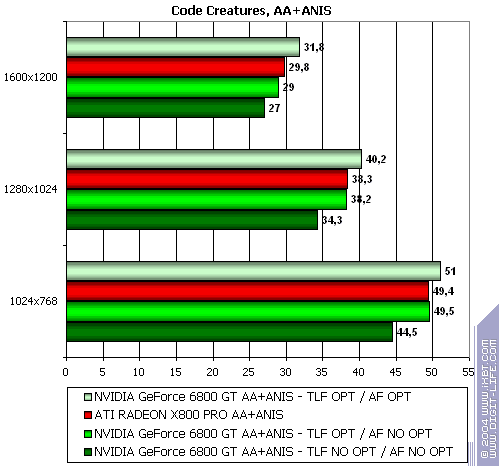  The lightest modes without AA or anisotropy: GT wins easily. The heaviest mode with AA and anisotropy: a parity. Total:
Evidently, optimisations brought about a substantial gain here too.
Unreal Tournament 2003

  In all the modes:
Again, optimisations bring about a visible gain.
Unreal II: The Awakening

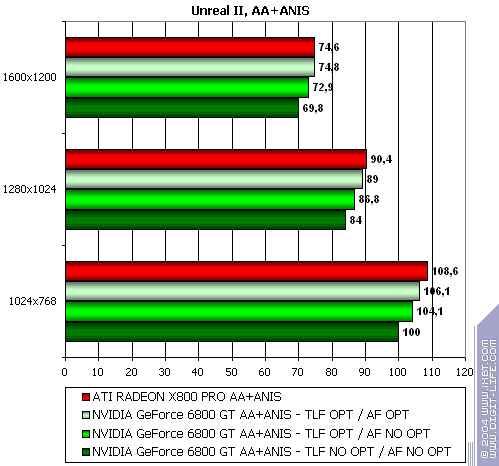  The lightest modes without AA or anisotropy: GT wins. The heaviest mode with AA and anisotropy: GT loses. Total:
Optimisations are effective though insignificantly.
RightMark 3D

  The lightest modes without AA or anisotropy: GT wins easily. The heaviest mode with AA and anisotropy: as the resolution grows, the victory turns into a loss. Total:
Optimisations are effective, but not that much. TR:AoD, Paris5_4 DEMO

  The lightest modes without AA or anisotropy: GT wins. The heaviest mode with AA and anisotropy: X800 PRO has a slim advantage. Total:
Optimisations bring about almost no effect as everything is limited by the power of the shader unit.
FarCry, demo01

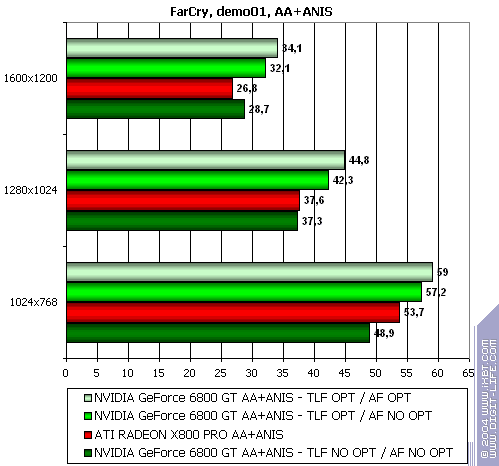  The lightest modes without AA or anisotropy: GT has a slight advantage. The heaviest mode with AA and anisotropy: GT's advantage has significantly increased. Total:
Wow, just look at the effect of the optimisations! As for the quality, it will be dealt with later.
Call of Duty, ixbt04

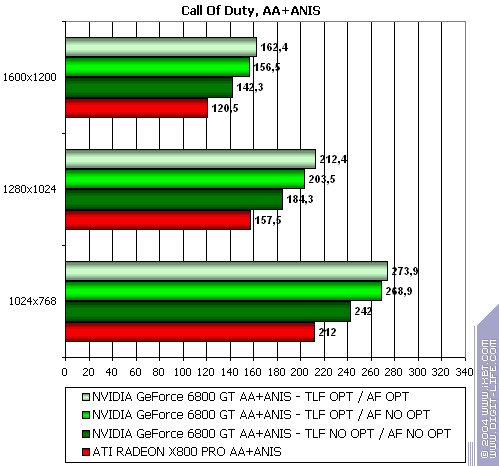  In all the modes:
Optimisations visibly raise performance.
HALO: Combat Evolved

 Total:
Optimisations are effective but not that much.
Half-Life2 (beta): ixbt07 demo
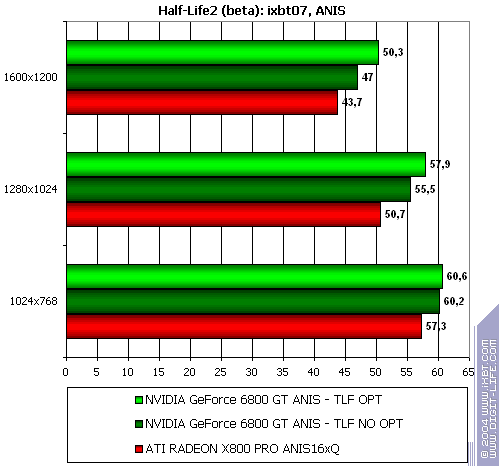
  The lightest modes without AA or anisotropy: GeForce 6800 GT is a success. The heaviest mode with AA and anisotropy: the picture is ambiguous, roughly, a parity. Total:
Optimisations are quite effective.
Splinter Cell

 Total:
Optimisations were of no use here due to the specifics of the game and some software peculiarities limiting it. ConclusionsLeaving quality issues aside, GeForce 6800 GT is clearly a more powerful accelerator than X800 PRO. If they were sold at equal prices, the former would be much more preferrable as it is faster in most tests. But there are not many places where the difference is really huge. However, there are too few 6800 cards for the moment, and what price will be for GT is anyone's guess. Considering that GeForce 6800 Ultra are sold from $550 to $700, chances are GT will be cheaper (-$100). As for power requirements, GT has them lower than Ultra, so 300-360W will be quite enough. The one-slot design makes the card fit for any case, and only a longer PCB may hinder the card's installation in the barebone. Also noteworthy is the card's heating, as its core temperature reached 80°C even when the cover was removed. Well, we're waiting for serial cards to appear. I can say if their retail prices are within USD 500 in Russia, they will be just swept away from the counters. (Well, times change indeed: it hasn't been long since we wrote that the cards would hardly be in demand if they cost over USD 400.) And don't forget about overclocking: many GTs will be able to work at 400/1100 MHz. You can see more detailed comparisons of various videocards in our 3DiGests.
Write a comment below. No registration needed!
|
Platform · Video · Multimedia · Mobile · Other || About us & Privacy policy · Twitter · Facebook Copyright © Byrds Research & Publishing, Ltd., 1997–2011. All rights reserved. | |||||||||||||||||||||||||||||||||||||||||||||||||||||||||